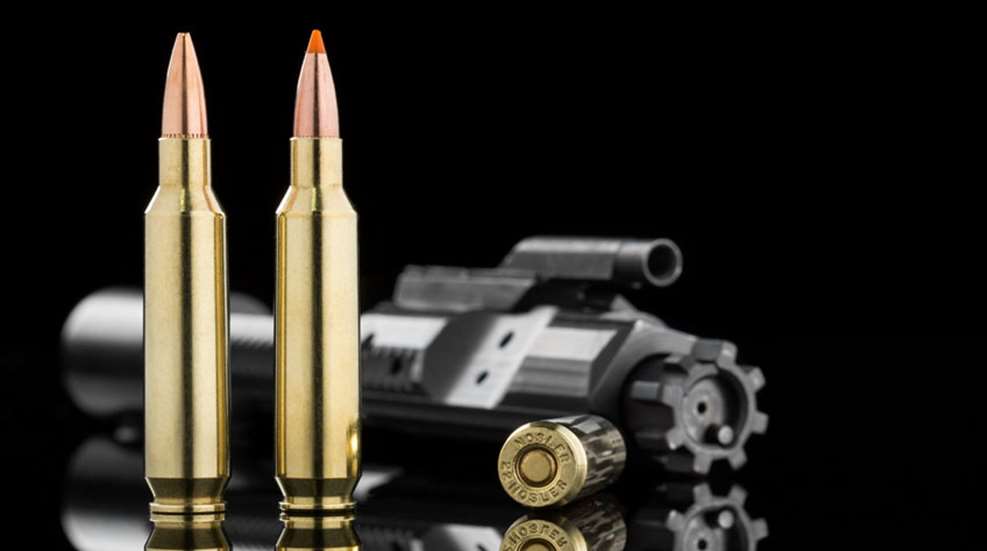
Some will argue the world doesn’t need more rifle cartridges. Most pushing this position are not enamored with the AR-15. Designed around the .223 Rem./5.56 NATO cartridge almost 60 years ago, the AR-15 is now the most popular rifle in the Untied States. And, AR-15 enthusiasts want—demand—their selection of cartridges be as extensive as those for bolt-action rifles. With an already sizeable variety of commercial and wildcat AR-15-compatible cartridges to choose from, Nosler might have just created the best ballistic option yet with its new 22 Nosler.
The 22 Nosler was designed to offer a substantial increase in external and terminal-ballistic performance over the .223 Rem. Nosler claims an increase in velocity and energy at 500 yards of 14 percent and 30 percent, respectively. What we’re talking here is essentially .22-250 Rem. performance. A performance increase of this magnitude is achieved either by increasing case capacity or operating pressure. Nosler chose the former.
Using larger-capacity cases in the AR-15 to increase ballistic performance is nothing new. Wildcatters have been doing this for years. However, unlike Nosler, these wildcatters have been utilizing cases that not only have more capacity, but larger rim diameters, too. This means converting your AR-15 also necessitated the acquisition of a new bolt and magazine. Nosler wanted to make the conversion from a .223 Rem. to the 22 Nosler easy so, yes, the company used a case with more capacity, but they rebated the rim so it would work with the same bolt used by the .223 Rem.
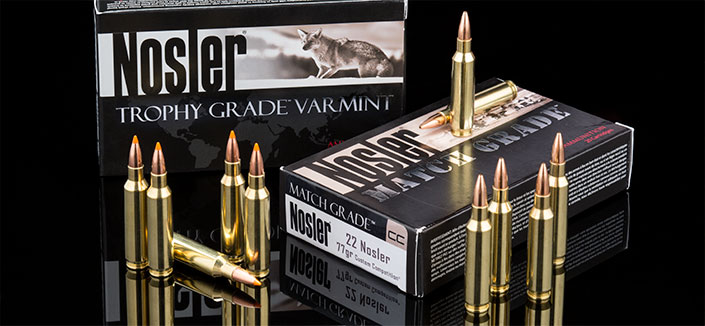
The Origin
About 10 years ago, an enterprising wildcatter from Illinois by the name of Roy Winnett created a cartridge he called the 22 PDK (Prairie Dog Killer). The 22 PDK was based on the 6.8 SPC cartridge case, and it has a case capacity of about 36 grains. As I wrote when I edited the “13th Edition of Cartridges of the World,” “While the cartridge [22 PDK] does not offer a substantial advantage over the .22-250 Rem. in a bolt-action rifle, it is indeed a lighting rod in an AR-15.”
Apparently, someone at Nosler took note. The 22 Nosler is for all practical purposes a 22 PDK—a necked down 6.8 SPC case—with a rebated rim. Instead of the standard .417 rim diameter of the 6.8 SPC (22 PDK) the 22 Nosler has a .378-inch rim diameter that matches that of the .223 Rem.
Now, since the 22 Nosler case is larger in diameter than that of a .223 Rem. you’re probably already wondering if it is possible to chamber a .223 Rem. cartridge in a 22 Nosler. If that could be done the excess chamber space would create an unsafe condition that might result in a damaged rifle or injured shooter. As it turns out, the shoulder of the .223 Rem. cartridge is set farther forward than that of the 22 Nosler. This means a .223 Rem. cartridge will not chamber in a 22 Nosler, thus preventing a potentially disastrous occurrence from taking place.
Both the 22 Nosler and the .223 Rem. are loaded to a SAAMI-dictated maximum average pressure (MAP) of 55,000 psi, but the new 22 Nosler has 18 percent more powder capacity than the .223 Rem. Based on Nosler’s published load data with a 55-grain bullet, this translates to an increase in muzzle velocity of about 200 to 300 fps. OK, maybe the 22 Nosler is not a .22-250 Rem., but it’s noticeably more than a .223 Rem.
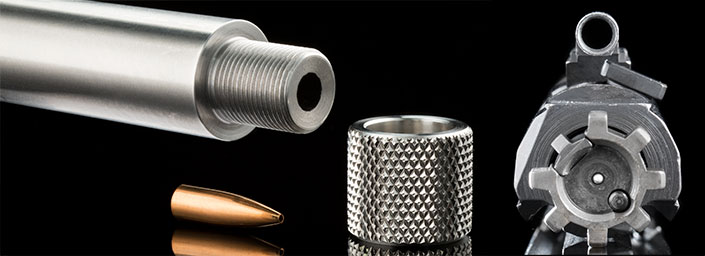
The Advantage
What does this mean downrange? Well, a 55-grain Nosler Ballistic Tip started at 3,200 fps—.223 Rem. velocities—will drop more than 4 feet (53.5 inches) at 500 yards. The same bullet out of a 22 Nosler at 3,500 fps will only drop about 43 inches. Just as importantly, the bullet fired from the 22 Nosler will impact at 130 fps faster than one from the .223 Rem. Accordingly, it will hit with about 16 percent more energy. Additionally, an often-overlooked aspect of terminal ballistics is the impact velocity needed to optimize bullet expansion. With its higher velocity, the new round will deliver good bullet expansion at greater distances.
All of this is, of course, paper speculation. The only way to really know what the 22 Nosler is capable of is to shoot it. Nosler provided an upper receiver built around a 1:8-inch twist, 24-inch Shilen stainless barrel, with a rifle-length gas system, and a .73-inch gas port. The upper was installed on a DPMS lower that had been fitted with a Timney trigger, and a SIG Sauer Tango6 5-30x56 mm riflescope was mounted for sighting purposes. The two factory loads Nosler provided were tested first.

The Test
The 77-grain Custom Competition load averaged 2,990 fps with an amazingly low standard deviation of only 8 fps. The average size of five, five-shot groups from a sandbag rest at 100 yards was 1.48 inches. Based on the dozens of AR-15s I’ve tested over the years, this is slightly better than average precision. I’d also note the muzzle velocity Nosler lists for its factory-loaded .223 Rem. using the same bullet is 2,550 fps and its advertised velocity for the factory 22 Nosler load tested is 2,950 fps.
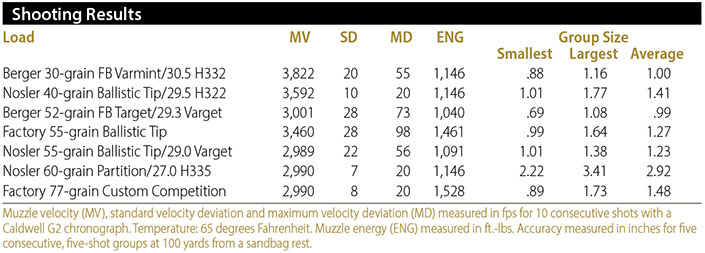
With the 55-grain Ballistic Tip load the 22 Nosler averaged 3,460 fps, but velocities were a bit less consistent. However, precision improved to an average group size of only 1.27 inches. The advantage of this load over similarly loaded .223 Rem. ammunition was 360 fps and, like with the 77-grain load, the factory 22 Nosler ammunition outperformed its advertised velocity, this time by 110 fps.
Handloads
Regardless the cartridge you shoot, if you’re going to shoot a lot, factory ammunition gets expensive. I wanted to try some handloads to see how easy the 22 Nosler was to reload, and to see what kind of performance I could get with various bullets. Using an excellent set of Redding Competition Dies, five loads with bullets ranging in weight from 30 to 60 grains were assembled. For a propellent, a mid-range powder charge was selected from the supplied Nosler data.
While a limited handloading test like this is not definitive by any means, I discovered several things: The first was that the upper receiver functioned perfectly with every load tested. The cartridge seems to be very reliable in the AR-15 platform. Second, it is apparently easy to make this cartridge shoot very well. Three of the five handloads averaged less than MOA for five, five-shot groups at 100 yards, and I did not try to “tune” these loads.

Advantage to the New?
The real question is if the 22 Nosler provides any real practical advantage over the .223 Rem. in the AR-15 platform. Based on my testing, if you’re shooting at extended distances, the answer is a resounding yes. With the 77-grain Custom Competition bullet at 500 yards in a 10 mph cross wind, you’ll see 16.8 inches less drop and some 5.3 inches less wind drift than you would using Nosler’s 77-grain Custom Competition factory load for the .223 Rem. The bullet will also strike the target with 47 percent more energy.
In close quarters or defensive-type situations, the advantage of the 22 Nosler might not be as clear-cut. Because of the larger case diameter, which necessitates the use of 6.8 SPC magazines, capacity is slightly reduced. However, using a barrier-defeating bullet like the Nosler Partition or an expanding projectile like the Ballistic Tip, impact velocities with the 22 Nosler are substantially higher, which will result in increased wounding.
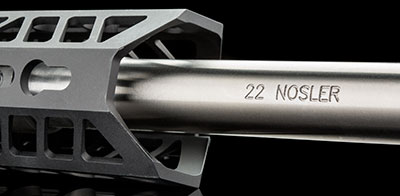
The downside, at least for now, is ammunition cost. 22 Nosler ammunition retails for a little more than a buck a round, while top-end .223 Rem. ammunition sells for a little less. The real discrepancy is with affordable practice or plinking ammunition. If you go with steel cases or catch a good sale, you can buy .223 Rem. ammunition for as little as 30 cents per round. I doubt you’ll ever see 22 Nosler ammo that cheap. This leaves handloading as your only viable option to reduce ammunition cost.
In short, if you want to play, you gotta pay. The 22 Nosler clearly offers some of the best ballistics you can get from an AR-15. Though it doesn’t hit as hard, it shoots flatter and handles the wind almost as well as the 6.5 Grendel cartridge AR aficionados are so outrageously starry-eyed about. That’s more than enough justification for a new cartridge. For that, you can thank Illinois wildcatter Roy Winnett for having the original vision, and Nosler for making it an easy and across-the-counter reality.






































